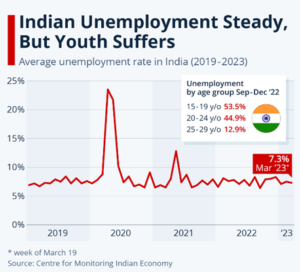Unemployment requires innovative solutions.
Relevance
- GS 3: Unemployment.
- Tags: #IndianEmployment #UnemploymentAnalysis #IndianEconomy. #PolicyChallenges #UPSC #MintEditorial #Employment #currentaffairs.
Why in the News?
India’s unemployment rate has risen despite improved employment opportunities. This apparent paradox is explained by factors like increased education levels and expanded social security measures.
Improvement in India’s Employment Situation
The National Statistics Office initiated the Periodic Labor Force Survey (PLFS) in 2017, offering regular updates on employment.
- Data reveals a consistent improvement in employment conditions from 2017 to 2021.
- During this period, there has been a noticeable increase in both labor force participation and workforce participation
- Combining these figures with the estimated population growth reveals a significant rise in employment availability.
- Compared to the 2011-12 survey (EUS), the employment situation in 2021-22 is notably improved.
Mixed Trends in Indian Unemployment
While employment opportunities have improved, Indian unemployment rates have risen since 2011-12.
- The gap was most pronounced in 2017-18 but has since narrowed.
- However, even comparing 2021-22 to 2011-12, unemployment rates are higher across all categories.
- Rural male unemployment has doubled since 2011-12.
- The combination of increased unemployment rates and a growing population indicates a larger workforce actively seeking employment.
Understanding the Unemployment contradiction
A possible explanation for India’s paradoxical unemployment situation is-
- The impact of significant economic events like demonetization in November 2016 and
- The implementation of GST in mid-2017.
- These changes are believed to have shocked the economy, especially the informal sector, which is thought to still experience the repercussions, leading to elevated unemployment rates.
- Meanwhile, improved GST collections are seen as a reflection of the formal sector’s performance.
- The notion that demonetization and COVID-19 led to increased unemployment and reverse migration from urban to rural areas is challenged by data showing a higher number of individuals identifying as ‘self-employed’ today compared to the past.
- This suggests that self-employment might have absorbed some of the workforce affected by these events.
Categories of Self-Employed Workers
Economically, self-employed workers fall into three categories:
- Own account workers (self-employed individuals).
- Employers.
- Workers in household enterprises.
Own-account workers and employers often represent informal sector enterprises in economic analyses.
Steady Self-Employment Trends
- In 2011-12, 2% of workers identified as self-employed, and this proportion grew to 55.8% by 2021-22.
- This trend remains consistent even when focusing on those categorizing themselves as own-account workers or employers.
- Considering the population increase during this period, the data indicates a substantial rise in the number of informal organizations, highlighting the resilience of self-employment in India’s labor landscape.
Steady Earnings in the Informal Sector
- Although direct comparisons with the EUS (Employment Unemployment Survey) are unavailable, the PLFS provides data on the average monthly earnings of self-employed workers.
- The data indicates a rise between 2017 and 2022, which is consistent with earnings from casual work.
- As a result, it is doubtful that informal businesses’ contribution to value creation has significantly reduced.
- This implies that the adverse effects of demonetization and GST on employment may not be a primary reason for India’s rising unemployment rate.
Challenging the Reverse Migration Claim
- The theory of reverse migration due to factors like COVID-19 doesn’t go with the evidence.
- A special study in 2021 found that migration rates in 2020-21 were similar to those in 2007-08.
- Additionally, the proportion of workers who typically engage in agriculture had decreased between 2011-12 and 2021-22.
- This data suggests that reverse migration and increased dependency on agriculture aren’t significant contributors to the current unemployment situation.
Understanding the Rise in Unemployment
The increased unemployment in India cannot be attributed to a significant decline in the informal sector or a widespread return to agriculture. Instead, a closer examination of the data reveals key factors contributing to this trend.
Youth Unemployment and Education
- Firstly, youth unemployment has surged, nearly doubling between 2011-12 and 2021-22.
- Moreover, individuals with higher levels of education face higher unemployment rates.
- This suggests that increasing education levels among the youth play a significant role.
- As education improves, more educated individuals are reluctant to accept unskilled work, resulting in continued unemployment.
- It’s noteworthy that since 2017-18, there has been a noticeable improvement in youth employment across various education categories, indicating an enhancement in job opportunities.
Impact of Social Security Measures
- Another factor contributing to the increased unemployment rate is the expansion of social security measures.
- The government has extended the distribution of affordable food through the National Food Security Act, relieving individuals of the immediate need to seek employment and allowing more time for job hunting.
- This, in turn, contributes to the rise in the unemployment rate compared to 2011-12 when such social security measures were not as prevalent.
- Additionally, direct cash transfers to farmer households and vulnerable groups have provided support, impacting the employment landscape.
The increase in unemployment can be attributed to structural shifts in the economy, including higher education levels and expanded social security measures. These changes do not necessarily indicate a lower quality of life. Addressing high unemployment, especially among educated youth, requires innovative solutions rather than traditional measures like MNREGA.
Source: Livemint
Mains Question
Examine the factors that may have led to an increase in India’s unemployment rates, despite an improvement in job opportunities since 2011-12?




